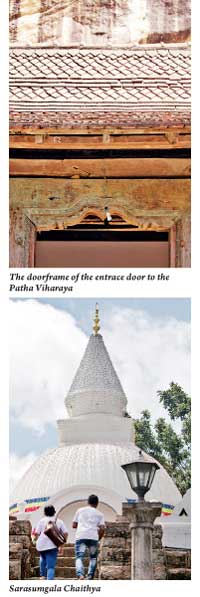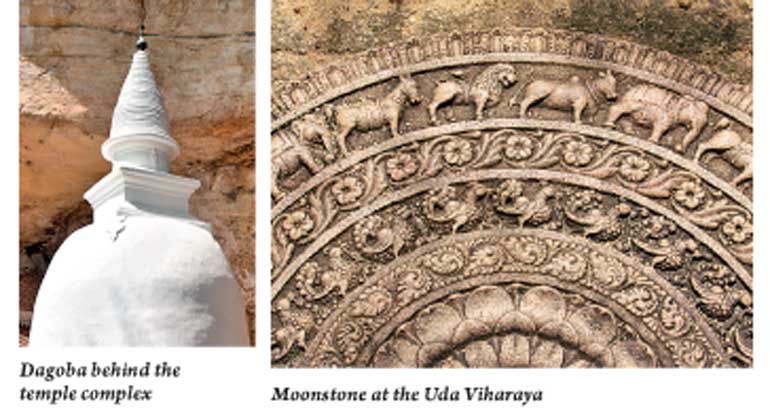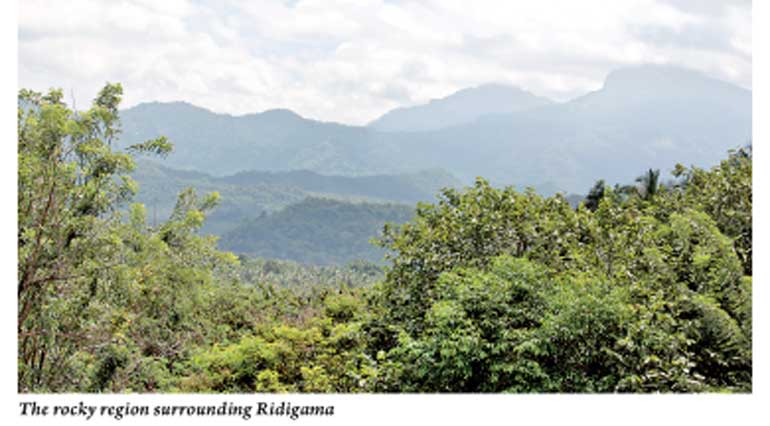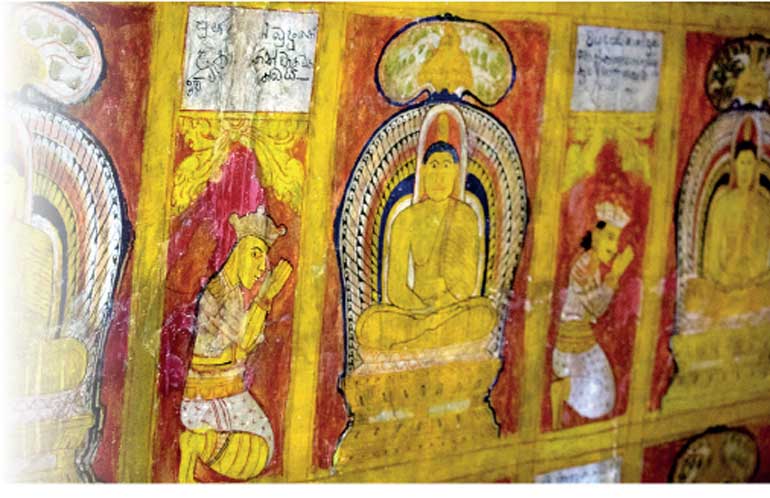Sunday Apr 20, 2025
Sunday Apr 20, 2025
Saturday, 11 November 2017 00:30 - - {{hitsCtrl.values.hits}}
By Aysha Maryam Cassim
The road to the Silver Temple
Ridi Viharaya makes a good stop when travelling towards Matale or other ancient cities of Anuradhapura, Polonnaruwa, Sigiriya or Dambulla from Kurunegala.
Located 20 kilometres away from the Kurunegala town, you can reach Ridi Viharaya conveniently by car or bus. Proceed along the main Kurunegala-Kandy road and turn to the left at the junction in Mallawapitiya. Drive towards Ridigama for about 13km passing Barandana, Kavisigamuwa and 2km from the town, you will be directed to a road uphill that leads you to the Raja Maha Viharaya.
Ridi Viharaya in Ridigama is known as the cave temple where silver was found. Tucked away on a hilly terrain in the outskirts of Kurunegala District, this Viharaya can be found built on a rock outcrop, standing about 200 feet high. The temple complex consists of Maha Viharaya (Pahala Viharaya), Udu Viharaya, Waraka Walandu Viharaya, Paththini Devalaya and Sarasum Gala Chaithya.
When I visited the temple this month, the Silver Cave aka Rajatha Lena of the Viharaya was framed with scaffolding. Several art students from state universities who were assigned to sketch the architectural details of the temple were present around Patha Viharaya where the frescoes were being restored. But pilgrims and travellers were allowed to enter the temple for religious observances.
 Rajatha Lena is a massive rock above the temple, which resembles a cobra head. The intimidating rock formation reminded me of the Pride Rock of Lion King’s kingdom. This cave is considered as the place where the original silver ore was found.
Rajatha Lena is a massive rock above the temple, which resembles a cobra head. The intimidating rock formation reminded me of the Pride Rock of Lion King’s kingdom. This cave is considered as the place where the original silver ore was found.
A merchant discovers a silver ore – a folktale
‘Ridi’ means silver in Sinhala. Ridi Viharaya derived its name from the silver, which was miraculously discovered at the temple site.
Ridi Vihara Asna relates an interesting tale behind the legend of this Silver Temple. During King Dutugemunu’s reign in ancient Sri Lanka [161-137 BC], from Anuradhapura, there was a route running to Malaya Rata across Ridigama. Once a merchant who was travelling through this path had pulled over his bullock cart to take a respite from his journey. When he woke up, he realised that his oxen were stolen. While the merchant was looking for them in the thick forest, he discovered a ripe jackfruit in a tree.
At that period, it was customary to offer a part of something that you cherish to an Arahath Thero residing in the area. The merchant offered a portion of his waraka to Indraguptha Thero. After consuming the fruit for his meal, the monk had shown the direction to the lost merchant to proceed along.
While resuming his journey on foot, the merchant had come across a silver ore inside a cave. Thrilled by this miraculous discovery, he went to Anuradhapura and informed the King about it. Upon the merchant’s news, the King sent his Ministers to the said place and had brought the silver to the kingdom. The village where the silver ore was found is now known as Ridigama and the temple as Ridi Vihara or the Silver Temple.
It is believed that King Dutugemunu used this silver to construct his colossal masterpiece and the largest Buddhist temple in Sri Lanka – Ruwanwali Maha Saya in Anuradhapura. As a gesture of gratitude, the king erected the Ridi Viharaya as a lasting monument at the location of the silver lode.
The Sangha generation of Ridi Viharaya
Ancient Brahmi inscriptions on the slates found in the temple premises suggest that Buddhist monks inhabited the caves of Ridi Viharaya 2,500 years ago. There are approximately 25 caves around Ridi Viharaya. Since the arrival of Arahat Mahinda, monastic monks mediated and sought shelter and spirituality in the serene atmosphere of the surroundings.
Historians believe that various monarchs, including Anandagamani Abaya, King Parakramabahu I (1153-1186 CE), and King Nishshankamalla contributed to the prosperity of Ridi Viharaya during the Polonnaruwa Kingdom. They sponsored the reconstruction and expansion of this temple. But it was only during King Kirthi Shri Rajasinghe’s reign (1747-1782) that the temple was recognised and revived as a Raja Maha Viharaya. Mahavansa gives us a lengthy account of its development over the course of history.
The Sangha generation of Ridi Viharaya temple can be traced back to Ven. Thibbatuwawe Sri Siddhartha Buddha Rakkhitha and Sri Siddhartha Saranankara Nayake Thero. At present, the Chief incumbent position of the historic Ridi Vihara in Kurunegala District is held by Viharadhipathi Thibbatuwawe Sri Siddhartha Sumangala Maha Thero, who is also the senior-most Anunayaka of the Malwatte chapter.
Every year, under the guidance and supervision of Ridhi Viharadhipathi Sri Siddhartha Sumangala Thero, the pageantry of historical Ridi Vihara Esala Perahara and the perahera of the Kumara Bandara Devalaya unfold through Ridigama, illuminating the streets with firelights.
 Frescoes and statues of Pahala Vihara
Frescoes and statues of Pahala Vihara
The most prominent Viharaya of the Ridi Viharaya temple complex lies beyond the Warakha Walandu Viharaya. The main temple, which is known as Pahala Viharaya today was built into a cave beneath the Rajatha Gala. The weather-beaten frescoes on the cave are hardly distinguishable. Inside the temple, you’d find a The Dragon Arch (Makara Thorana) and a series of Buddha statues along with the huge sleeping Buddha to the left-hand side of the cave.
The most intriguing feature here is the ceramic platform that has been adorned with blue-and-white Flemish tiles, depicting biblical scenes and village life in Holland. In J.B Dissanayake’s ‘Rataka Mahima – Ridi Vihare’, he mentions that these tiles might have been donated by a Dutch ambassador to the Kandyan court as a gift.
Udu Viharaya
From Paatha Viharaya to Udu Viharaya, one has to go through a door that has an intricate door frame with an ivory carving of Pancha Naari Gataya – a figure of five entwined maidens. On either side of the ivory carving, there are two lions surrounded by floral creepers.
The image house of the upper temple has a seated Buddha statue guarded by another magnificent dragon arch. The walls of the temple are adorned with Kandyan Kingdom cave paintings. These frescoes are a collaboration of masterpieces by Devaragampola Silwaththana and artisans of Nilagama generation.
Serasumgala Chaithya
To the right of the entrance, there is a stone stairway to Serasum Gala Chaithya. This small dagoba is perched on a boulder overlooking the rocky region of Dolukanda, Ritigala Kanda, Atipola Kanda. The rock is believed to be the place where King Dutugamunu dressed prior to worshipping the temple.
The temple where a monk had jackfruit
One of the biggest attractions of the Ridi Vihara complex is Waraka Walandu Viharaya. The Mandapaya-like stone structure was originally constructed as a Hindu temple and was later converted into a Buddhist shrine around the eleventh century. The ornate carvings that represent cultural scenes of the past bear semblance to the architectural and artistic details of a Hindu Devalaya built during the Polonnaruwa Kingdom.
According to a folklore, during the Anuradhapura Kingdom, an Arahat Thero named Indraguptha had consumed a ripe jack fruit in this location and henceforth, the name ‘Waraka Walandu Viharaya’ (the temple where the bhikkhu had jackfruit) was used.



Discover Kapruka, the leading online shopping platform in Sri Lanka, where you can conveniently send Gifts and Flowers to your loved ones for any event including Valentine ’s Day. Explore a wide range of popular Shopping Categories on Kapruka, including Toys, Groceries, Electronics, Birthday Cakes, Fruits, Chocolates, Flower Bouquets, Clothing, Watches, Lingerie, Gift Sets and Jewellery. Also if you’re interested in selling with Kapruka, Partner Central by Kapruka is the best solution to start with. Moreover, through Kapruka Global Shop, you can also enjoy the convenience of purchasing products from renowned platforms like Amazon and eBay and have them delivered to Sri Lanka.
Discover Kapruka, the leading online shopping platform in Sri Lanka, where you can conveniently send Gifts and Flowers to your loved ones for any event including Valentine ’s Day. Explore a wide range of popular Shopping Categories on Kapruka, including Toys, Groceries, Electronics, Birthday Cakes, Fruits, Chocolates, Flower Bouquets, Clothing, Watches, Lingerie, Gift Sets and Jewellery. Also if you’re interested in selling with Kapruka, Partner Central by Kapruka is the best solution to start with. Moreover, through Kapruka Global Shop, you can also enjoy the convenience of purchasing products from renowned platforms like Amazon and eBay and have them delivered to Sri Lanka.